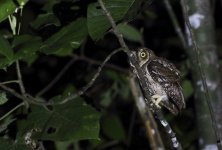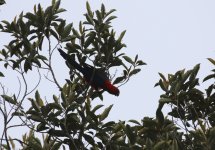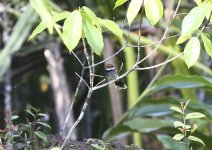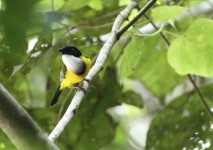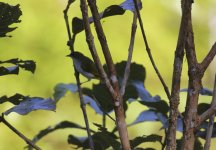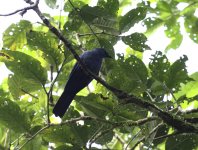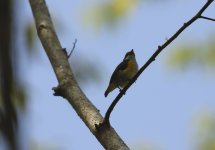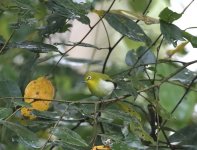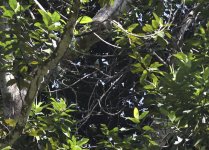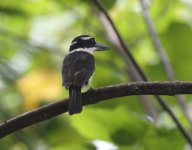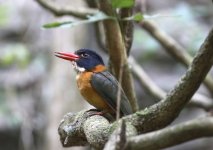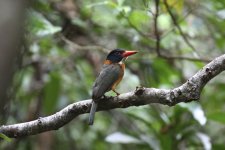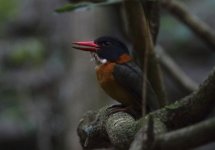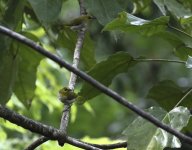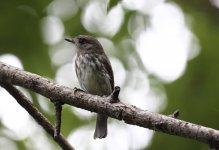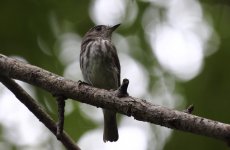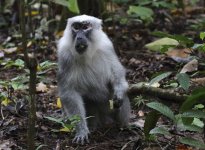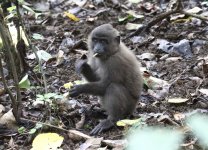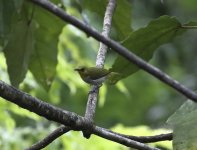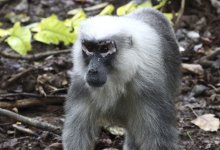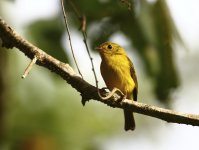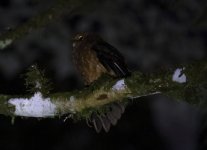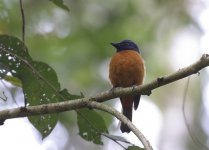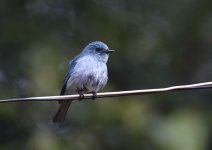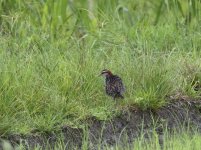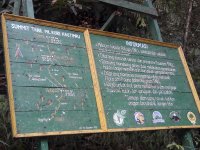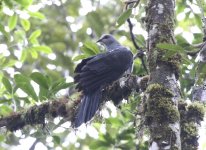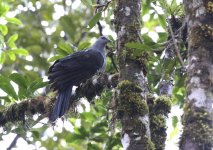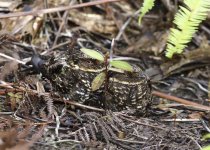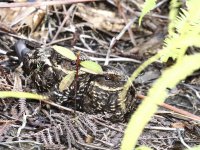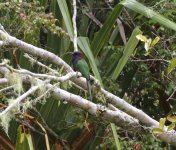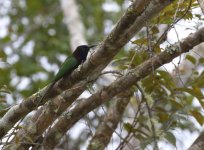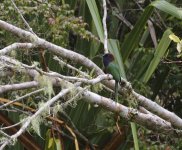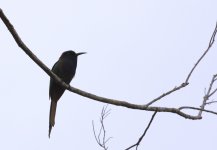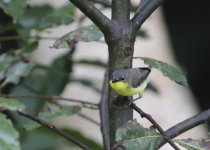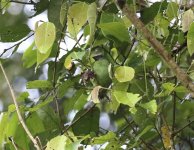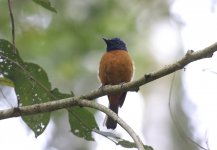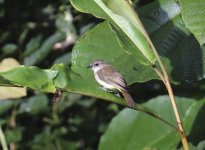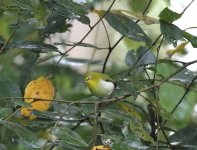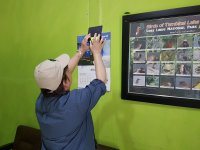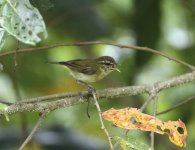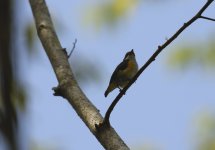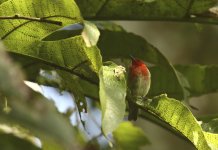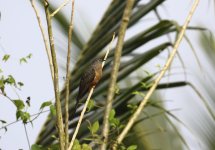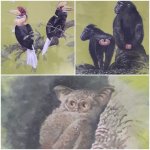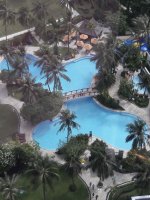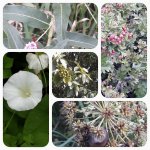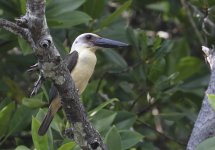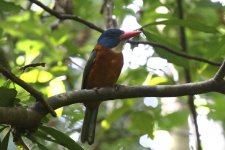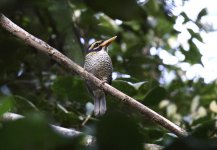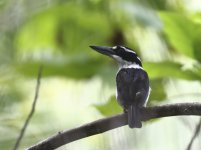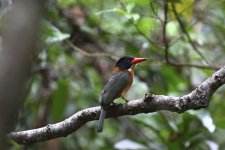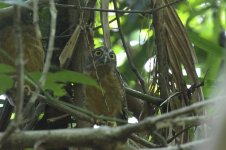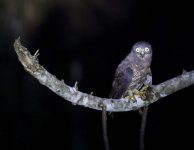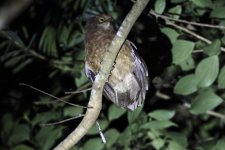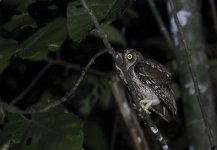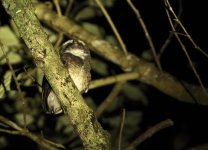Off to the area near the Weda Bay Nickle mine.
Early breakfast, even with a start before 4am they offer full selection of pancakes, eggs, etc so Weda Resort is well set up for birders in addition to having some great birds in the local area and very comfortable accommodation.
We headed toward the Weda bay port and stopped to try for Moluccan Scops Owl but again no sign of Bob although we did get another Halmahera Boobook fly in to nearby trees. We persevered for the scops owl and this time when we switched the torches back on and had a scan of the trees there was a couple of Moluccan Scops Owls but quite distant after a little more calling, and hearing Bob.., Bob.., Bob... one of the birds came close enough and perched for a record shot although he wouldn’t show completely out in the open.
It was just getting light as we passed through the last town before the road split and we took the fork towards the Nickle Mine, I don’t think this road is used very much – we certainly didn’t see another car in a full day on the road and only saw a few people near the mining town and then two people late in the day near the start of the road. The road gets to a high enough elevation to get the few tricky birds that only occur at 1200M or above. The first birds we spotted were a small flock of the beautiful Chattering Lory, what a shame that these birds are all being trapped and kept in cages in the local villages. We then added Wallacean Monarch, Cinnamon-bellied Imperial Pigeon and Moluccan Monarch, at the highest point of the road just before the Nickle Mine town we had good views of two Gilolo Fantails flying around with a couple of Halmahera White-eyes. We also found a couple of North Moluccan Leaf Warblers which were quite confiding
We heard a distant Moluccan King Parrot but despite lots of attempts to call it in we could see this target bird but we did add Wallacean and Halmahera Cicadabirds and the Dusky Myzomela.
We heard a Scarlet-breasted Fruit Dove and Bang-bang managed to see it, even though it was well set back in a tangle of vines high up in a tree, fortunately I got on it quickly and even managed a distant record shot of this beautiful dove but Sarah just couldn’t get on it despite three of us giving her directions and me showing her a photo to try to get her to look through the right gap in the vegetation, the scope was in the car a good 30 minute walk away and we had visions of her missing this great bird when fortunately it moved slightly and she was on it, “I don’t believe I couldn’t see it” – doh! To be fair we have all been there where everyone but you is on a bird and you just get frustrated as hell as you are at the wrong height, angle, or bird is hidden by a leaf, branch etc….
We were then walking up and down the hill calling and trying for a Rufous-necked Sparrowhawk which had been seen here a few weeks ago but without luck, we were however lucky to see a fly-over Gurney’s Eagle which we were able to see well by running to the brow of the hill as it initial went out of sight and a Varied Goshawk.
Bird activity had pretty much stopped so we had lunch on a table of banana leaves set out on the road, we then had a siesta just laying on the road, only to be disturbed by a heavy rain shower an hour or so later. While the rain didn’t last long, just 40 minutes with us sheltering under umbrellas, there was little bird activity – then we saw Umbrella Cockatoo, then we heard another King Parrot and there below in the middle of tree was a Moluccan King Parrot. This is now a pretty rare bird in this part of Halmahera.
We walked and birded down the road with Bang-bang driving behind and with Carlos on top of the car, birds added included Dollarbird, Blue and White Kingfisher, Moluccan Cuckooshrike and Long-billed Crow.
The heavy rain had brought a tree down across the road - whilst we had a machete in the car it was going to take ages to get the tree cleared; but our good luck continued - two guys collecting coconuts had good blades and made short work of clearing the tree and were happy to be rewarded with some biscuits and sweets.
In a clearing on the way back just before dark we added Peregrine Falcon, Indonesian Kestrel and Oriental Hobby.
Early breakfast, even with a start before 4am they offer full selection of pancakes, eggs, etc so Weda Resort is well set up for birders in addition to having some great birds in the local area and very comfortable accommodation.
We headed toward the Weda bay port and stopped to try for Moluccan Scops Owl but again no sign of Bob although we did get another Halmahera Boobook fly in to nearby trees. We persevered for the scops owl and this time when we switched the torches back on and had a scan of the trees there was a couple of Moluccan Scops Owls but quite distant after a little more calling, and hearing Bob.., Bob.., Bob... one of the birds came close enough and perched for a record shot although he wouldn’t show completely out in the open.
It was just getting light as we passed through the last town before the road split and we took the fork towards the Nickle Mine, I don’t think this road is used very much – we certainly didn’t see another car in a full day on the road and only saw a few people near the mining town and then two people late in the day near the start of the road. The road gets to a high enough elevation to get the few tricky birds that only occur at 1200M or above. The first birds we spotted were a small flock of the beautiful Chattering Lory, what a shame that these birds are all being trapped and kept in cages in the local villages. We then added Wallacean Monarch, Cinnamon-bellied Imperial Pigeon and Moluccan Monarch, at the highest point of the road just before the Nickle Mine town we had good views of two Gilolo Fantails flying around with a couple of Halmahera White-eyes. We also found a couple of North Moluccan Leaf Warblers which were quite confiding
We heard a distant Moluccan King Parrot but despite lots of attempts to call it in we could see this target bird but we did add Wallacean and Halmahera Cicadabirds and the Dusky Myzomela.
We heard a Scarlet-breasted Fruit Dove and Bang-bang managed to see it, even though it was well set back in a tangle of vines high up in a tree, fortunately I got on it quickly and even managed a distant record shot of this beautiful dove but Sarah just couldn’t get on it despite three of us giving her directions and me showing her a photo to try to get her to look through the right gap in the vegetation, the scope was in the car a good 30 minute walk away and we had visions of her missing this great bird when fortunately it moved slightly and she was on it, “I don’t believe I couldn’t see it” – doh! To be fair we have all been there where everyone but you is on a bird and you just get frustrated as hell as you are at the wrong height, angle, or bird is hidden by a leaf, branch etc….
We were then walking up and down the hill calling and trying for a Rufous-necked Sparrowhawk which had been seen here a few weeks ago but without luck, we were however lucky to see a fly-over Gurney’s Eagle which we were able to see well by running to the brow of the hill as it initial went out of sight and a Varied Goshawk.
Bird activity had pretty much stopped so we had lunch on a table of banana leaves set out on the road, we then had a siesta just laying on the road, only to be disturbed by a heavy rain shower an hour or so later. While the rain didn’t last long, just 40 minutes with us sheltering under umbrellas, there was little bird activity – then we saw Umbrella Cockatoo, then we heard another King Parrot and there below in the middle of tree was a Moluccan King Parrot. This is now a pretty rare bird in this part of Halmahera.
We walked and birded down the road with Bang-bang driving behind and with Carlos on top of the car, birds added included Dollarbird, Blue and White Kingfisher, Moluccan Cuckooshrike and Long-billed Crow.
The heavy rain had brought a tree down across the road - whilst we had a machete in the car it was going to take ages to get the tree cleared; but our good luck continued - two guys collecting coconuts had good blades and made short work of clearing the tree and were happy to be rewarded with some biscuits and sweets.
In a clearing on the way back just before dark we added Peregrine Falcon, Indonesian Kestrel and Oriental Hobby.




